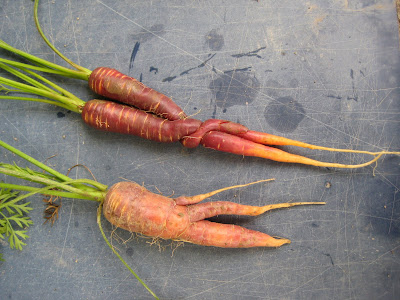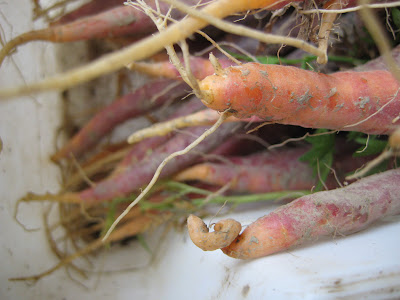
The bee guy came today to take care of the three hives that he maintains here on Michaele's property. These are mostly Italian bees, with a few Russian bees mixed in. The Russian bees came from neighboring beehives as he originally had purely Italian bees. The Russian and Italian bees can interbreed and live happily as a family in one hive.
The Hive
The hive is comprised of two parts: the body of the hive, which are the large boxes underneath, and the honey supers, which are the shorter boxes on top. The bottom boxes are where the queen lays her eggs and where the bees store honey for themselves. The top boxes are where the bees store honey that the bee-keeper harvests. Today the bee guy was removing the full frames of honey from the supers and replacing these with empty frames ready to be filled.

Removing a super.

Removing a honey-filled frame covered in bees. The bees are more aggressive this time of year because this is the time of year that bears come to raid hives. The bees think the bee guy is a bear and they try to sting him a lot. To remove the bees from the frame the bee guy shakes it and then nudges the remaining bees off with his fingers.



This is an empty frame. The honeycomb you see here is a plastic base that is given to the bees to build off of. The bees will extend off of this base with wax, thereby creating an even honeycomb that is easier for the beekeeper to process than honeycombs build without a base, which are generally quite uneven.

This is a frame that is filled with honey. After the bees make the honeycomb from wax they fill the cells with nectar. Then they flap their wings hard to make the water evaporate from the nectar, thus creating honey. When the honey is ready they cap off the cells with more wax, creating the equivalent of canned honey, which they will open and consume in the winter time.

 The Honey Extractor
The Honey Extractor

Honey Extracting
The honey-filled frame is placed into the honey extractor's tub. Then the tub spins around really fast. The honey flies out due to centrifugal force and falls to the bottom of the tub, then flows out through the tap.
The honey extraction is very messy and must be done in an air-tight room. Bees are attracted to honey "like heroin", according to the bee guy. If you do it in a non-air-tight room the bees will kill themselves trying to fly in through tiny holes. If you do it outside the whole area will be covered in bees.

The Nucleus Hive
There was a swarm of bees from one of the hives the other day; this happened because that hive got over crowded. The swarm was going to establish a new hive elsewhere. Michaele called the bee man when this happened. He came and took some more bees out of that hive and put them into a nucleus-hive: a small brown box.
I found this lovely little bee-keepers rhyme on Wikipedia:
A swarm of bees in May is worth a load of hay;
A swarm of bees in June is worth a silver spoon;
A swarm of bees in July isn't worth a fly.
The reason for this is that bees that swarm in spring or early summer relieve overcrowding in hives and create another hive, therefore creating even more honey. They will have all season to stock up on nectar and turn it into honey for eating in the winter. But the bees that swarm in late summer or fall will not have all season. They may not have enough time to stock up and might not survive the winter. This is why they aren't "worth a fly" to bee-keepers.

The Birth of a Queen
This box is lacking a queen; sensing this the bees begin feeding some larvae royal jelly, a special protein-rich substance that they secrete from gland on their heads. These specially-fed larvae will develop into queen bees. In the above photo the lumps of wax that look like peanuts are where the queen larvae are growing. When the first one hatches out it will go around and kill all the other queen larva.
The African Honey Bee
This process is key to why the aggressive African honey bee is so problematic here. Unlike the European varieties, which have been bred for centuries to be docile, the African honey bee is very aggressive. Additionally, when a new African honey bee queen larva is growing it will hatch one or two days before Italian or Russian larva; therefore, whenever there are African honey bee queen larva in the hive, it is this queen that will survive. This is why the African honey bee has taken over other varieties and is so difficult to get rid of in many parts of the states. But it does not whether cold winters well and thus is not a problem in this area.
Drones
In the photo above, the larger bees are the drones; these are the male bees. Their only purpose is to mate with the queen. The worker bees are all female. The drones can comprise up to 10% of the hive but there are usually much fewer in artificial hives. Only 10-20 drones are needed to mate with the queen; otherwise they are useless and use up space and food. They also require larger cells to grow as larva. Beekeepers provide frames for their bees with the base framework for only small cells, thus fewer drone eggs are laid (the queen bee automatically lays drone eggs in larger cells and worker eggs in smaller cells). The workers find places to make some larger cells for drone eggs, but there are many fewer than in natural hives.
Reproduction
The queen bee has one mating flight in her life. During this flight she mates with 10-20 drones. She stores their sperm in a special organ in her abdomen that keeps it alive her whole life as she lays eggs every day, all day.
Sources:
The beekeeper guy (most of the information)
http://www.californiastatebeekeepers.com/swarmsinfo.htm (why swarming in spring is better for bee-keepers than swarming in late summer)
Swarming (honey bee). Wikipedia http://en.wikipedia.org/wiki/Swarming_(honey_bee) (the rhyme and about royal jelly)
Sorry there aren't more close-ups but I didn't want to get stung!






















































